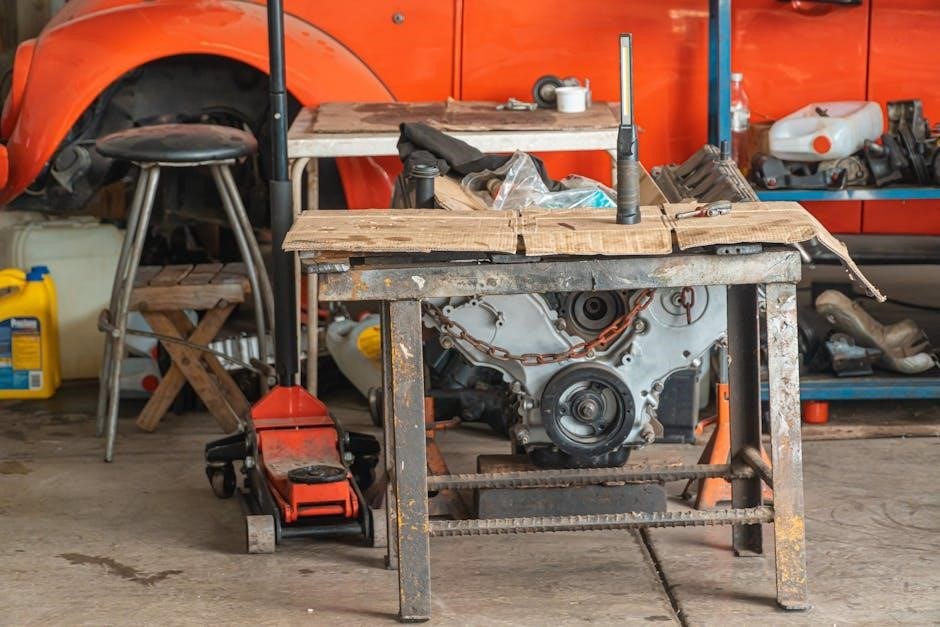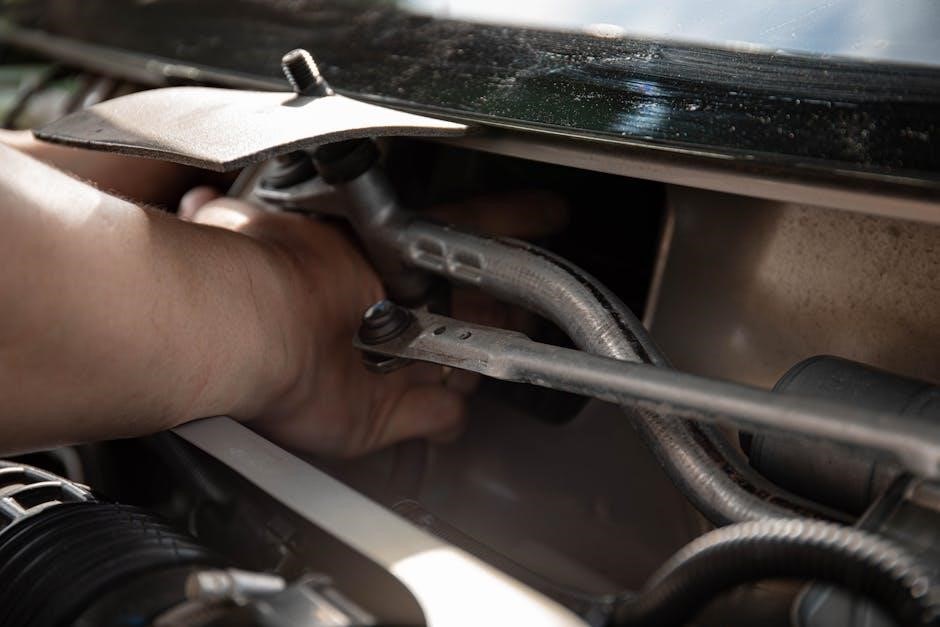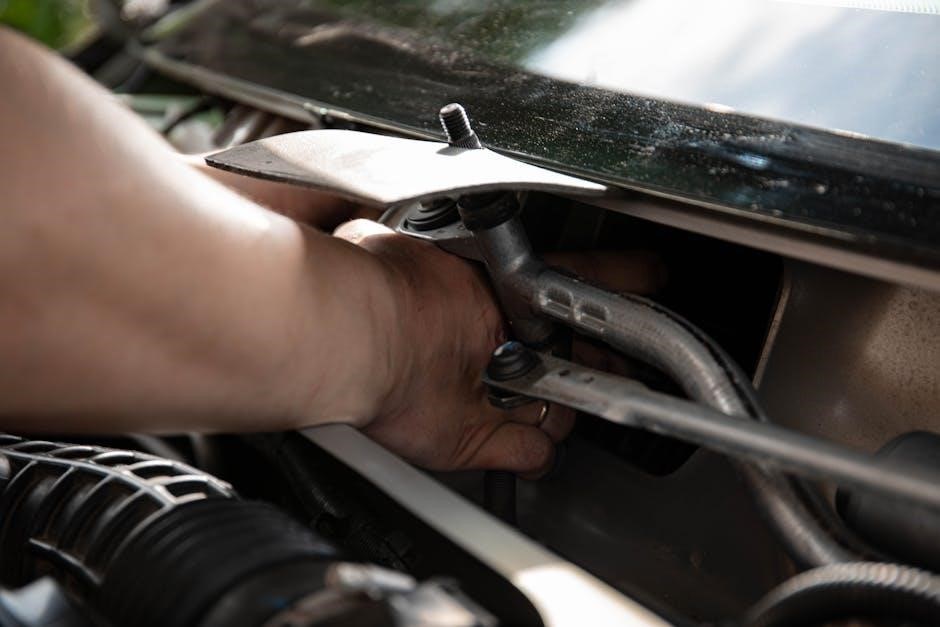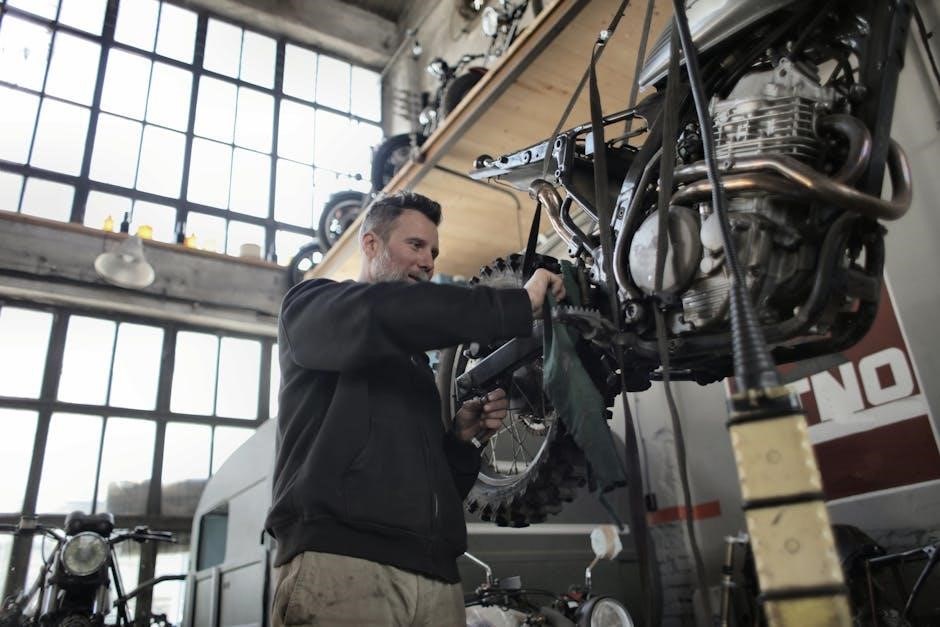Club Car service manuals provide detailed guidance for maintaining and repairing various models, including Precedent, Carryall, and Onward series․ They offer diagrams, troubleshooting tips, and maintenance schedules to ensure optimal performance and safety․ These manuals are essential for DIY enthusiasts and professionals, covering electrical and mechanical systems, battery care, and seasonal adjustments․ Regular updates ensure compliance with the latest technical specifications and industry standards, making them indispensable for Club Car owners and technicians․
Overview of Club Car Service Manuals
Club Car service manuals are comprehensive guides designed to help users maintain, repair, and troubleshoot their vehicles effectively․ These manuals cover a wide range of models, including the Precedent, Carryall, and Onward series, ensuring compatibility with both gas and electric vehicles․ They provide detailed technical specifications, repair procedures, and safety guidelines to ensure optimal performance․ Whether you’re a DIY enthusiast or a professional technician, these manuals offer step-by-step instructions for routine maintenance and complex repairs․ Topics include electrical systems, battery care, and mechanical components, all presented in an organized and easy-to-follow format․ Available in PDF format, these manuals are accessible on various platforms, making them a valuable resource for Club Car owners and service providers․
Importance of Using Official Service Manuals
Using official Club Car service manuals ensures access to accurate and reliable technical information tailored to specific models․ These manuals are developed by Club Car experts, guaranteeing precision and relevance for maintenance, repairs, and troubleshooting․ They include detailed diagrams, part lists, and step-by-step procedures, reducing the risk of errors․ Official manuals also ensure compliance with safety standards and warranty requirements, protecting both the vehicle and the user․ DIY enthusiasts and professionals alike benefit from the comprehensive guidance, which covers electrical, mechanical, and battery systems․ Regular updates in official manuals reflect the latest technical advancements, ensuring users have the most current information․ This makes official Club Car service manuals indispensable for maintaining vehicle performance, safety, and longevity․
How to Download Club Car Service Manuals
To download Club Car service manuals, visit the official Club Car website or authorized dealers for genuine PDF versions․ Ensure you select the correct model and year for accuracy․ Third-party websites may also offer free or paid access, but verify their credibility to avoid outdated or incorrect information․ Some platforms require subscriptions for premium access to updated manuals․ Always check for the latest editions to ensure compliance with current technical specifications․ Downloading from trusted sources guarantees reliable guidance for maintenance, repairs, and troubleshooting․ Regular updates are crucial for staying informed about new features and improvements․
Key Features of Club Car Service Manuals
Club Car service manuals are comprehensive guides offering detailed diagrams, wiring schematics, and step-by-step instructions for repairs and maintenance․ They include troubleshooting sections for common issues, such as electrical or battery problems, and provide maintenance schedules to ensure optimal performance․ Manuals are model-specific, covering gas and electric vehicles, including popular series like Precedent, Carryall, and Onward․ They feature parts lists with OEM specifications, ensuring accurate replacements․ Additionally, these manuals include safety precautions, torque specifications, and diagnostic tools guidance․ Regular updates reflect the latest technical advancements and industry standards, making them indispensable for both DIY enthusiasts and professional technicians․ These resources enhance safety, efficiency, and compliance with manufacturer recommendations․

Club Car Models and Specifications
Club Car offers a variety of models, including the Precedent, Carryall, Onward, and TransPorter series, with specifications for electric and gas-powered vehicles, catering to diverse needs and applications․
Precedent Series Service Manuals
Precedent series service manuals provide comprehensive guides for maintaining and repairing Club Car’s popular Precedent golf carts․ These manuals cover both electric and gas-powered models, offering detailed diagrams, troubleshooting tips, and step-by-step repair procedures․ They include maintenance schedules, parts listings, and diagnostic techniques to ensure optimal performance and longevity․ The manuals emphasize safety practices, electrical system diagnostics, and mechanical repairs, making them essential for DIY enthusiasts and professional technicians․ Regular updates ensure compliance with the latest technical advancements and industry standards․ Whether addressing common issues or performing routine maintenance, Precedent series manuals are indispensable for anyone working on these vehicles․ They are available for download from official Club Car sources or authorized third-party websites, ensuring easy access to critical information․
Carryall Series Service Manuals
Carryall series service manuals are designed to assist users in maintaining and repairing Club Car’s utility vehicles, known for their durability and versatility․ These manuals cover both gas and electric models, including the Carryall 295, 500, and 550 series․ They provide detailed instructions for routine maintenance, such as battery care and tire pressure checks, as well as complex repairs like engine overhauls․ The manuals include wiring diagrams, troubleshooting guides, and parts lists, making them invaluable for both professionals and DIYers․ Regular updates ensure that the manuals reflect the latest technical specifications and safety guidelines․ By following the procedures outlined in these manuals, users can extend the lifespan of their vehicles and ensure optimal performance in various work environments․ They are available for download from official Club Car sources and authorized dealers, providing easy access to essential information․
Onward Series Service Manuals
Onward series service manuals provide comprehensive instructions for maintaining and repairing Club Car’s Onward electric and gas-powered vehicles․ These manuals are tailored to specific models, offering detailed guidance on routine maintenance, such as battery care and fluid checks, as well as advanced repairs like electrical system diagnostics and engine overhauls․ They include wiring diagrams, troubleshooting guides, and parts lists, making them essential for technicians and DIY enthusiasts․ The manuals are regularly updated to reflect the latest technical advancements and safety standards․ By adhering to the procedures outlined, users can ensure optimal performance, reliability, and longevity of their Onward vehicles․ These manuals are available for download from Club Car’s official website and authorized dealers, ensuring easy access to accurate and up-to-date information․
TransPorter Series Service Manuals
TransPorter series service manuals are designed to help users maintain and repair Club Car’s TransPorter utility vehicles, including electric and gas-powered models․ These manuals provide detailed instructions for routine maintenance, such as oil changes and battery inspections, as well as complex repairs like engine overhauls and electrical system troubleshooting․ They include wiring diagrams, parts lists, and diagnostic procedures, ensuring technicians and owners have the information needed to keep their vehicles running efficiently․ The manuals cover specific models, such as the TransPorter 4, and are updated regularly to reflect the latest technical advancements․ By following the guidelines in these manuals, users can extend the lifespan of their TransPorter vehicles and ensure optimal performance for both commercial and recreational use․

Maintenance and Service Procedures
Maintenance and service procedures are crucial for ensuring Club Car vehicles operate safely and efficiently․ Regular routines include battery checks, oil changes, and tire inspections․ Seasonal adjustments and proper storage practices are also emphasized to maintain performance and longevity․
Routine Maintenance Schedule
A well-structured routine maintenance schedule is essential for prolonging the lifespan and performance of Club Car vehicles․ Regular tasks such as oil changes, tire pressure checks, and battery inspections ensure optimal functionality․ The schedule typically includes daily, weekly, and monthly checks, with detailed guidelines provided in the service manual․ Key tasks involve lubricating moving parts, inspecting brakes, and monitoring electrical connections․ Seasonal adjustments, such as preparing the vehicle for winter storage, are also outlined to prevent damage․ Adhering to the recommended schedule helps prevent unexpected breakdowns and ensures safety․ Always refer to the specific manual for your Club Car model to follow the tailored maintenance plan․ Proper adherence guarantees reliable operation and extends the vehicle’s service life․

Battery Maintenance and Replacement
Proper battery maintenance is crucial for ensuring reliable performance and extending the lifespan of your Club Car vehicle․ Regular inspections should include checking electrolyte levels, terminals, and cables for corrosion or damage․ Charging should be done in a well-ventilated area, avoiding overcharging, which can damage the battery․ When replacing batteries, ensure they meet the specifications outlined in the service manual․ Always wear protective gear, such as gloves and goggles, during maintenance․ Store batteries in a cool, dry place when not in use․ Improper handling can lead to safety hazards, so adhering to the manual’s guidelines is essential․ Refer to the Club Car service manual for detailed procedures on testing, charging, and replacing batteries effectively․
Common Repairs and Parts Replacement
Common repairs for Club Car vehicles often involve replacing worn or damaged components such as brake shoes, tires, and electrical connections․ The service manual provides step-by-step procedures for these tasks, ensuring safety and optimal performance․ For example, replacing the brake system components requires careful alignment and torque specifications to maintain proper function․ Additionally, frequent issues like faulty solenoids or corroded battery terminals are addressed with detailed troubleshooting guides․ When replacing parts, it’s crucial to use genuine Club Car components or approved equivalents to avoid compatibility issues․ The manual also includes diagrams to help locate and identify parts, making the repair process more efficient․ Regularly updating your manual ensures you have the latest repair procedures and parts information․
Seasonal Maintenance Tips
Seasonal maintenance is crucial for optimizing your Club Car’s performance and longevity․ During winter, ensure the battery is fully charged and stored in a cool, dry place to prevent degradation․ In spring, inspect tires for wear and proper inflation, and check brakes for functionality․ Summer months require regular cleaning of electrical connections and lubrication of moving parts to combat heat and humidity․ Fall maintenance should include checking the suspension and steering systems for alignment and inspecting the condition of the seat and canopy․ Always refer to your Club Car service manual for specific seasonal recommendations tailored to your model․ Regular seasonal checks help prevent unexpected issues and ensure your vehicle remains reliable year-round․

Troubleshooting and Repair
Club Car service manuals outline step-by-step troubleshooting for common issues like electrical faults, battery problems, and mechanical failures, ensuring effective diagnosis and repair․
Common Issues and Solutions
Club Car service manuals address common issues such as battery drainage, electrical system malfunctions, and mechanical faults․ For battery-related problems, manuals recommend checking connections, charging systems, and water levels; Electrical issues often involve faulty sensors or corroded wires, which can be identified using multimeters․ Mechanical problems, like cart acceleration or braking issues, are typically resolved by inspecting and replacing worn components․ The manuals provide step-by-step solutions, ensuring DIY enthusiasts and technicians can efficiently diagnose and repair problems․ Regular maintenance, as outlined in the manuals, helps prevent these issues, extending the lifespan of Club Car vehicles and optimizing their performance․ These solutions are designed to be user-friendly, ensuring safety and reliability for all users․
Electrical System Troubleshooting
Club Car service manuals provide comprehensive guides for diagnosing and resolving electrical system issues․ Common problems include faulty sensors, corroded connections, and malfunctioning solenoids․ Manuals recommend using multimeters to test voltage and continuity, ensuring accurate diagnoses․ For example, low battery voltage or faulty charging systems can be identified through specific tests․ Corrosion in connectors or wires is another frequent issue, often resolved by cleaning or replacing damaged components․ The manuals also cover OBD system checks for modern models, helping technicians pinpoint errors quickly․ Detailed wiring diagrams and step-by-step instructions simplify the troubleshooting process․ Regular electrical system maintenance, as outlined in the manuals, helps prevent issues and ensures reliable performance․ These resources are invaluable for both professionals and DIY enthusiasts, promoting safety and efficiency in electrical repairs․
Mechanical System Repairs
Club Car service manuals detail procedures for repairing mechanical systems, including brakes, suspension, and drivetrain components․ Common issues like worn brake pads or faulty hydraulic lines are addressed with step-by-step instructions․ Manuals provide torque specifications and disassembly guidelines for critical parts such as axles and gearboxes․ Lubrication schedules are emphasized to prevent premature wear on moving components․ Troubleshooting sections help identify problems like uneven tire wear or vibration, often linked to misaligned wheels or unbalanced driveshafts․ Detailed diagrams and exploded views simplify complex repairs, ensuring accuracy․ By following manual guidelines, owners can restore optimal performance and safety to their vehicles․ Regular mechanical checks, as recommended, help prevent major breakdowns and extend the lifespan of Club Car models․
Battery and Charging System Issues
Club Car service manuals provide comprehensive guidance for diagnosing and resolving battery and charging system problems․ Common issues include corroded terminals, incorrect charging procedures, and imbalanced battery cells․ Manuals detail steps for testing battery voltage and specific gravity using multimeters and hydrometers․ Solutions often involve cleaning corrosion, replenishing electrolyte levels, and ensuring proper charging cycles․ Troubleshooting sections address symptoms like slow charging, inconsistent power output, or complete system failure․ Safety precautions, such as disconnecting batteries before repairs, are emphasized to prevent accidents․ Regular maintenance tips, like inspecting cables and checking water levels, help prevent issues․ By following manual recommendations, owners can optimize battery performance and extend the lifespan of their Club Car’s electrical system․ Proper care ensures reliable operation and minimizes downtime for both electric and gas-powered models․

Safety Precautions and Guidelines
Adhering to safety guidelines is crucial when servicing Club Car vehicles․ Always wear protective gear, including gloves and safety glasses, to prevent injuries during repairs․
Ensure proper ventilation when working with batteries or electrical systems․ Follow emergency procedures, such as disconnecting power sources, to maintain a safe working environment․
General Safety Practices
General safety practices are essential when working with Club Car vehicles․ Always wear protective gear, including gloves and safety glasses, to minimize injury risks during repairs․
Ensure the vehicle is on a level surface and apply the parking brake before starting any maintenance․ Proper ventilation is crucial, especially when handling batteries or electrical systems․
Consult the service manual for specific safety precautions tailored to your Club Car model․ Never bypass safety features or ignore warning labels, as this can lead to accidents or equipment damage․
Keep loose clothing and long hair tied back to avoid entanglement with moving parts․ Adhere to all safety guidelines to ensure a safe working environment and maintain vehicle reliability․
Protective Gear and Equipment
Protective gear and equipment are crucial for ensuring safety while servicing Club Car vehicles․ Always wear safety glasses or goggles to protect your eyes from debris or chemical splashes․
Gloves are essential for handling sharp or hot components, providing grip and preventing cuts․ Steel-toe boots or sturdy footwear should be worn to safeguard against heavy tools or falling objects․
A face mask is recommended when working with batteries or painting to avoid inhaling harmful fumes․ Additionally, keep a fire extinguisher nearby and ensure proper ventilation in the workspace․
Use insulated tools for electrical work to prevent shocks․ Regularly inspect protective gear for wear and tear, replacing it as needed․ Proper equipment ensures a safe and efficient service experience․
Safe Storage and Handling
Proper storage and handling of Club Car vehicles and their components are essential for maintaining safety and functionality․ Always store the vehicle in a dry, well-ventilated area, away from direct sunlight and flammable materials․ Ensure the parking brake is engaged and the vehicle is on a level surface to prevent accidental movement; When handling batteries, wear protective gloves and eyewear, and avoid short circuits․ Use approved lifting equipment to handle heavy parts, and never store unauthorized items in the vehicle․ Regularly inspect storage areas for hazards and ensure compliance with local safety regulations․ Proper organization of tools and parts prevents loss and damage․ Always follow the manufacturer’s guidelines for storage and handling to maintain the vehicle’s integrity and ensure safe operation․
Emergency Procedures
Club Car service manuals outline essential emergency procedures to ensure safety in critical situations․ In case of a fire, evacuate the vehicle immediately and use a fire extinguisher rated for electrical or fuel fires․ For collisions or rollovers, turn off the ignition, secure the scene, and contact emergency services․ If the vehicle becomes submerged, avoid electrical components and exit safely․ In the event of a battery acid spill, wear protective gear and neutralize the spill with baking soda․ Always disconnect the battery before performing repairs․ Keep emergency contact numbers handy and familiarize yourself with the manual’s emergency section․ Regularly inspect safety equipment like fire extinguishers and first aid kits․ Following these procedures ensures the well-being of occupants and bystanders during unexpected incidents․ Stay prepared and act calmly to minimize risks․ Proper training and awareness are key to handling emergencies effectively․

Diagnostic Tools and Techniques
Club Car service manuals emphasize the use of OBD systems, multimeters, and software tools for precise diagnostics․ These tools help identify electrical and mechanical issues efficiently․
Using OBD Systems for Diagnostics
Club Car service manuals highlight the importance of OBD (On-Board Diagnostics) systems for efficient troubleshooting․ These systems allow users to read fault codes, monitor sensor data, and perform diagnostic tests․ By connecting to the vehicle’s computer, OBD tools provide real-time insights into electrical and mechanical performance․ They are particularly useful for identifying issues in battery health, charging systems, and motor functionality․ OBD systems streamline the diagnostic process, saving time and ensuring accurate repairs․ Many modern Club Car models, including electric and gas-powered vehicles, support OBD connectivity․ Regular use of these tools helps maintain optimal performance and extends the lifespan of the vehicle․ The manuals guide users on how to interpret OBD data and address common faults effectively․

Multimeter and Electrical Testing
Multimeters are essential tools for diagnosing electrical issues in Club Car vehicles․ Service manuals provide detailed steps for using multimeters to measure voltage, current, and resistance․ This allows technicians to identify faults in batteries, motors, and wiring․ By testing electrical components, users can pinpoint issues like short circuits or faulty connections․ The manuals emphasize the importance of proper testing techniques to ensure accurate readings and prevent further damage․ Regular electrical testing helps maintain vehicle reliability and performance․ Whether troubleshooting or performing routine maintenance, a multimeter is a critical tool for any Club Car owner or technician․ The manuals also include charts and diagrams to guide users through complex electrical systems, making diagnostics more accessible and efficient․
Software Tools for Club Car Diagnostics
Club Car service manuals often recommend using specialized software tools for advanced diagnostics․ These tools enable users to connect to the vehicle’s onboard systems, providing real-time data and detailed fault codes․ Software like Club Car’s official diagnostic programs can monitor battery health, motor performance, and electrical systems․ They also offer guided troubleshooting to resolve issues efficiently․ Many tools are compatible with popular models such as the Precedent, Carryall, and Onward series․ By leveraging software diagnostics, technicians can identify problems quickly, reducing downtime and ensuring proper repairs․ Regular updates to these tools keep them aligned with the latest Club Car technologies, making them indispensable for modern maintenance and repair tasks․
Compression Testing and Engine Diagnostics
Compression testing is a critical diagnostic procedure outlined in Club Car service manuals to assess engine health․ This process involves using a compression gauge to measure the pressure within engine cylinders, helping identify issues like low compression, which can indicate worn piston rings or head gasket problems․ Manuals provide step-by-step instructions for performing accurate tests, emphasizing proper tool usage and safety precautions․ By analyzing compression readings, technicians can diagnose engine performance problems, such as misfires or lack of power․ Regular compression testing, as recommended in service manuals, ensures early detection of potential issues, preventing costly repairs․ This diagnostic method is particularly valuable for Club Car models with gasoline or diesel engines, ensuring optimal performance and longevity․

Downloading and Accessing Manuals
Club Car service manuals are accessible via official websites, authorized dealers, and third-party platforms․ Regular updates ensure compliance with the latest technical specifications and industry standards․
Official Club Car Manual Download Sources
Official Club Car service manuals are available through the Club Car website and authorized dealers․ Visit www․clubcar․com to access a dedicated section for service manuals, where you can search by model and year․ Authorized dealers also provide direct links to download manuals, ensuring authenticity and relevance․ Additionally, Club Car offers a dealer locator tool on their website, allowing users to find local distributors who can assist with manual downloads․ For convenience, some manuals are available in PDF format, enabling easy access and printing․ Always verify the source to ensure you are downloading genuine Club Car manuals, as unauthorized sources may provide outdated or incorrect information․ Regular updates are provided by Club Car to keep manuals current with the latest technical specifications and safety guidelines․

Third-Party Websites for Manual Access
Several third-party websites offer Club Car service manuals in PDF format for free or paid access․ Websites like ManualsLib and GolfCartManuals provide extensive libraries of Club Car manuals, including models such as Precedent, Carryall, and Onward․ These platforms allow users to search by model year and download manuals directly․ Some sites, like ClubCarDealer, also offer supplementary resources like parts listings and troubleshooting guides․ While third-party sources can be convenient, ensure the manual’s authenticity and relevance to your specific model․ Always verify the source to avoid outdated or incorrect information․ These websites are particularly useful for owners who prefer DIY maintenance or need immediate access to repair guidelines without contacting official dealers․
Subscription-Based Manual Services
Subscription-based manual services offer a convenient way to access Club Car service manuals in PDF format․ Platforms like ManualsLib and ClubCarDealer provide subscription models that grant users unlimited access to a vast library of manuals, including those for Precedent, Carryall, and Onward models․ These services often include additional benefits such as regular updates, new manual releases, and access to supplementary resources like wiring diagrams and troubleshooting guides․ Subscriptions are particularly useful for professionals or frequent users who need consistent access to technical information․ While some services require a fee, they ensure that users receive accurate and up-to-date content tailored to their specific needs․ Always choose reputable providers to guarantee the quality and relevance of the materials provided․
Importance of Regular Manual Updates
Regular updates to Club Car service manuals are crucial for ensuring accuracy and relevance; Manufacturers often release revised editions to incorporate new procedures, correct known issues, or add support for updated models․ These updates may include enhanced troubleshooting guides, revised maintenance schedules, or new diagnostic techniques․ Staying current with the latest manual versions ensures compliance with safety standards and industry regulations․ Additionally, updates often address common user feedback, improving clarity and usability․ For technicians and DIY enthusiasts, having the most recent manual guarantees access to the latest technical specifications and best practices․ Regular updates also ensure compatibility with new tools and technologies, making servicing more efficient and reliable․ Always prioritize using the latest versions to maintain optimal performance and safety for your Club Car vehicle․
